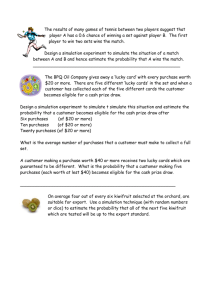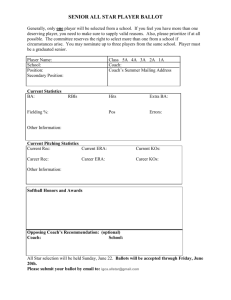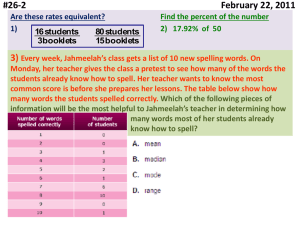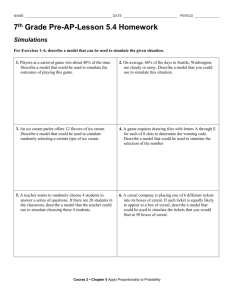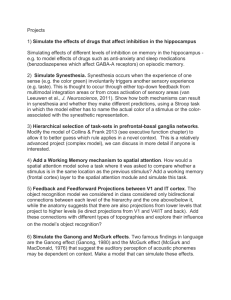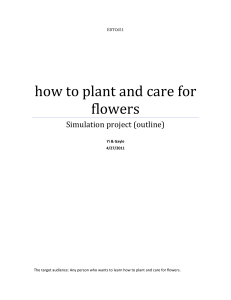Probability task centres - CED-Mxteachers-news-site
advertisement
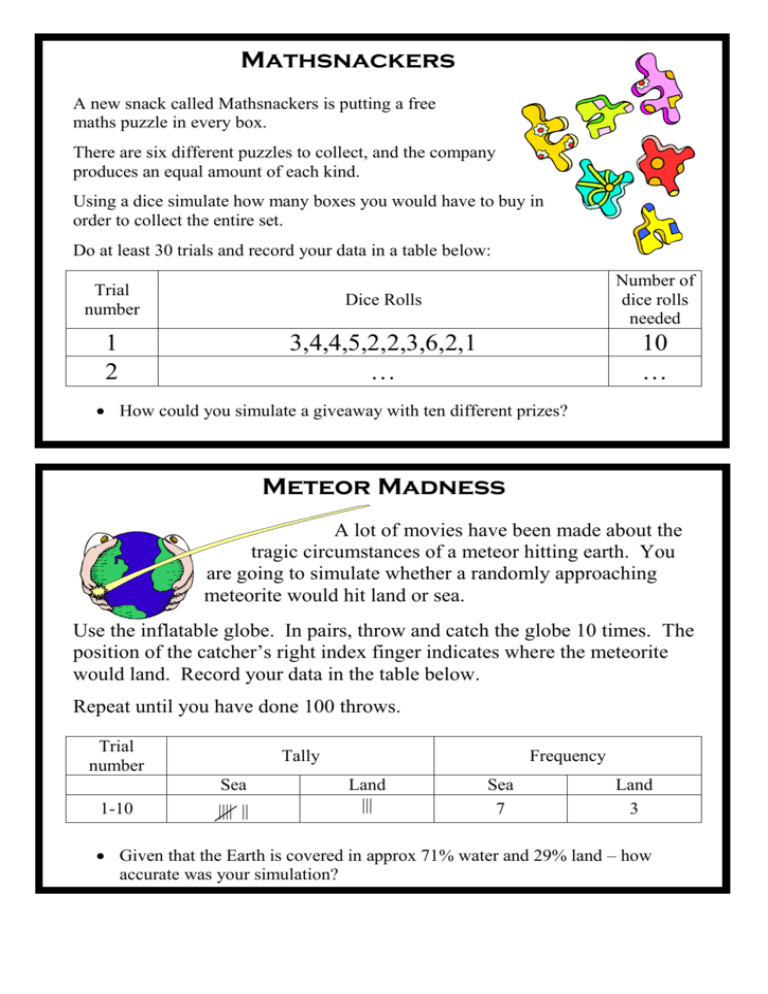
Mathsnackers A new snack called Mathsnackers is putting a free maths puzzle in every box. There are six different puzzles to collect, and the company produces an equal amount of each kind. Using a dice simulate how many boxes you would have to buy in order to collect the entire set. Do at least 30 trials and record your data in a table below: Trial number Dice Rolls Number of dice rolls needed 1 2 3,4,4,5,2,2,3,6,2,1 … 10 … How could you simulate a giveaway with ten different prizes? Meteor Madness A lot of movies have been made about the tragic circumstances of a meteor hitting earth. You are going to simulate whether a randomly approaching meteorite would hit land or sea. Use the inflatable globe. In pairs, throw and catch the globe 10 times. The position of the catcher’s right index finger indicates where the meteorite would land. Record your data in the table below. Repeat until you have done 100 throws. Trial number Tally Sea 1-10 |||| || Frequency Land ||| Sea 7 Land 3 Given that the Earth is covered in approx 71% water and 29% land – how accurate was your simulation? TRUE The truth of the matter FALSE You arrive at school and realise you have forgotten to study for a ten problem true/false test. What is the probability you will pass by just guessing? What is the probability that you get any particular question correct? Use a coin to simulate your answers to each question. ‘Do’ the test ten times? What is your average score? Test Number Answers Score (out of ten) 1 HTHHHTTHHT 6 2 … … Design a simulation to investigate what happens if a test has twenty questions. Does the probability increase, decrease or stay the same? Design a simulation for a Multi-choice test with A, B, C, D answers. A tacky problem In the movie Golden Eye James Bond uses tacks that always land point up to foil his enemies. This is obviously not true for ‘normal’ drawing pins. Your task is to investigate how many times a drawing lands ‘point up’, ‘point down’ or on its side. ‘Flip’ the drawing pin ten times. Repeat until you have done 100 trials. Trial Number 1-10 11-20 Point Up On its side Point Down Calculate the experimental probability for each. Is the probability that the pin lands point down 0? Why / Why not? Traffic Lights Driving to school each day, Tania goes through three traffic lights. The probability of any one light being green is light is not green is 1 , and the probability that any one 3 2 . 3 Create a simulation, to estimate the probability that Tamika will find all the lights green. Do at least 50 trials. Estimate the probability that Tamika will find at least one light to be not green. Trial Number 1 2 Light One Light Two Light Three Result Green … Red … Red … GRR … Draw a probability tree to calculate the theoretical probability of these two situations. Blood Type In New Zealand, approximately 45 percent of people have type O blood. These people are called universal donors because their blood can be used in transfusions for people of any blood type. Assume that blood donors arrive independently and randomly at the blood bank. Use the random number key (or otherwise) on your calculator to simulate 100 donors arriving at the donor station. Complete the table below: Trial Tally Universal donor Not universal donor Frequency Universal donor Not universal donor 1-10 Use the percentages below to design a simulation using all eight blood types. O Positive, 38%; A Positive, 34%; B Positive, 9%; O Negative, 7%; A Negative, 6%; AB Positive, 3%; B Negative, 2%; AB Negative, 1%. Free throw A basketball player shoots foul shots with a 75% accuracy record (that is, they score three out of every four attempts). If the first shot is successful, then a second shot is given. In this one-and-one situation, they can score 0,1, or 2 points. Simulate this player’s score for 50 trips to the free throw line. Complete the following table: Trial Number 1 2 First Attempt Second Attempt … … Score 1 … Use the results of your simulation to answer the following questions: 1. What is the average number of points per trip to the free-throw line? 2. What number of points occurs most? 3. For what fraction of the trips to the free-throw line did the player shoot twice? Investigate what happens if the player only makes 60% of their shots. What about if they make 90% of their attempts? Rock / paper / scissors Rock / Paper / Scissors is used in many countries to decide who gets to go first*. In the game, Rock beats Scissors, Paper beats Rock and Scissors beats Paper. Play this game 50 times against your partner. Record your information in the table below. Tally Trial Number Player One Frequency Player Two Player One Player Two 1-10 Design a simulation to simulate two people playing this game 50 times. How do your results compare with those of Task A? Investigate the theoretical probabilities of this game. (Hint: draw a probability tree). *In Indonesia they use Ant, Man and Elephant. Is it a fair game? Can you work out which beats which?
